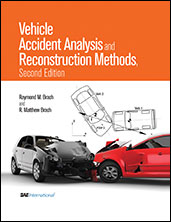Technical Paper
Reconstruction of Vehicle-Pedestrian Collisions Including an Unknown Point of Impact
2015-04-14
2015-01-1419
Numerous algebraic formulas and mathematical models exist for the reconstruction of vehicle speed of a vehicle-pedestrian collision using pedestrian throw distance. Unfortunately a common occurrence is that the throw distance is not known because no evidence exists to locate the point of impact. When this is the case almost all formulas and models lose their utility. The model developed by Han and Brach published by SAE in 2001 is an exception because it can reconstruct vehicle speed based on the distance between the rest positions of the vehicle and pedestrian. The Han-Brach model is comprehensive and contains crash parameters such as pedestrian launch angle, height of the center of gravity of the pedestrian at launch, pedestrian-road surface friction, vehicle-road surface friction, road grade angle, etc. Such an approach provides versatility and allows variations of these variables to be taken into account for investigation of uncertainty.

